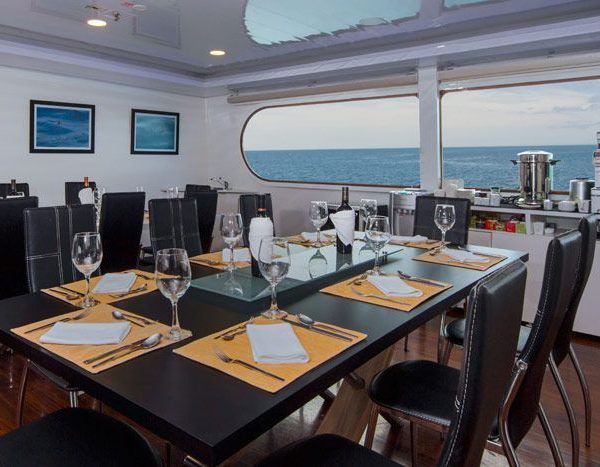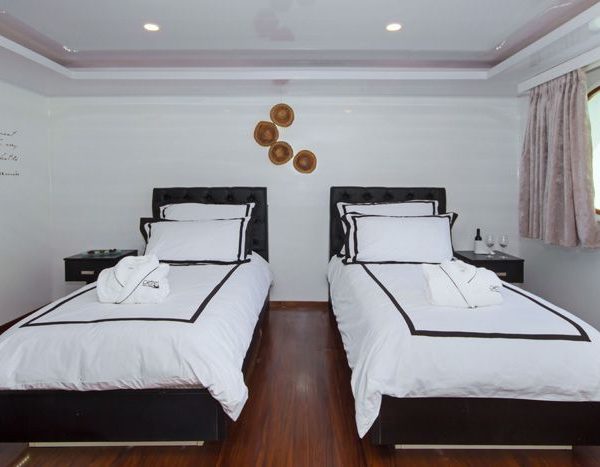Day 1: Friday
– AM – Arrival to San Cristobal Airport with transfer to M/C Petrel
Welcome to the Galapagos Islands aboard the M/C Petrel. The guide and crew will greet you and show you to your accommodations upon your arrival. Afterwards, the guide and cruise manager will hold a short briefing on all safety and emergency protocols, different areas of the vessel and the normal routine of the itinerary.
– PM – San Cristobal – Interpretation Center and Galapaguera
The Interpretation Center has been open to the public since 1998, offering extensive knowledge about the history of Galapagos. San Cristobal is also the island where Charles Darwin first landed on. It is now home to the capital of Galapagos and houses many government offices, as well as part of the Ecuadorian Navy. Giant tortoises are bred at the Galapaguera and roam in a semi-natural habitat created by the center.
Possible Activities: Introduction and walk in center
Difficulty: Easy
Type of Landing: Dry Landing
Highlights: Giant tortoises in various stages of their life.
Day 2: Saturday
– AM – Española Island – Gardner Bay / Osborn Islet
This white sandy beach is home to a large colony of sea lions and incredibly blue and turquoise waters. Three different finches can be seen, as well as the Española mockingbird. Over time, the mockingbird must have been offered water or food from tourists and now they have no fear of walking on your things or landing very close to you. It is so important not to feed or touch the animals. It can disrupt their normal behaviors and threaten their future.
Possible Activities: Walking on the beach and swimming.
Difficulty: Easy
Type of Landing: Wet landing
Highlights: Sea lions, various shorebirds, mockingbirds, stingrays, sea turtles.
– PM – Española Island – Suarez Point
This is a phenomenal site where you will get to see many of Española Island’s endemic species. The trail will pass by the only Waved Albatross breeding site in all of Galapagos. If you are lucky you might see a young albatross take off for its first flight for up to five years at sea. Older birds stay at sea for months at a time, only coming back to breed. They have the same mate for life and will meet each other each year, only here to reproduce. Other species that can be seen are marine iguanas that stay brightly colored year round, Galapagos doves, Nazca boobies, blue-footed boobies, swallow-tailed gulls, red-billed tropic birds, and Darwin finches.
Possible Activities: Hike
Difficulty: Easy/Moderate
Type of Landing: Dry landing
Highlights: Sea lions, marine iguanas, Galapagos hawk, waved albatross, red-billed tropic birds, various shorebirds, nazca boobies, swallow tailed gulls, finches and sally lightfoot crabs.
Day 3: Sunday
– AM – Floreana – Cormorant Point / Devil’s Crown
Cormorant is an interesting visitor site. Two beaches can be visited here, just beyond the first beach is a saltwater lagoon with flamingos. One of the beaches look green because of the olivine crystals, and the other is appropriately called Flour Beach because of the powdery white sand, made from fine, pulverized coral. Watch your feet if wading in the water, stingrays love to hang out here as well.
Devil’s Crown boasts one of the finest snorkeling opportunities. Below the surface are amazing volcanic structures that have submerged over time. Hundreds of colorful fish species can be seen along the reef, along with sharks, rays, sea turtles, sea lions, and rays. It’s a beautiful underwater spectacle that cannot be missed.
Possible Activities: Snorkeling and hiking
Difficulty: Snorkeling – Moderate to difficult / Hike – easy
Type of Landing: Wet landing
Highlights: frigatebirds, sea lions, sea turtles, galapagos sharks, white-tipped sharks, tropical fish, various shorebirds and seabirds, varied marine life.
– PM – Floreana – Post Office Bay
Ask the Cruise Manager for one of our complimentary postcards to write a message and address it home. Leave it in the barrel used before by pirates and sailors. While your there, see if there are any other postcards you can take home with you to send for fellow travelers who have already left their messages!
Possible Activities: Post office barrel, relaxing on the beach, swimming or snorkeling
Difficulty: Easy
Type of Landing: Wet Landing
Highlights: frigatebirds, sea lions, sea turtles, various shorebirds and seabirds, marine life.
Day 4: Monday
– AM – Santa Cruz – Charles Darwin Research Station
The Charles Darwin Research Station is one of the most important visitor sites when it comes to learning more about the evolution of both the wildlife and geology of the Galapagos Islands. With the station you can find many different interpretation centers on plant life, endemic wildlife, conservation projects, and even how a ladybug played a vital role in a new type of control against invasive intruders within the islands!
Possible Activities: Walking within the station
Difficulty: Easy
Type of Landing: Easy
Highlights: See the latest advancements in research, interesting interpretation centers, giant tortoises in different life stages, iguanas, endemic wildlife, finches, marine iguanas.
– PM – Santa Cruz – Highlands
The highlands of Santa Cruz are interesting due to the rich wildlife, hills, ferns, extinct volcanoes and lava tubes present. Throughout the highlands you can see the different agricultural zones where farmers plant a wide variety of fruits and coffee thanks to the rich volcanic soils. This area is great to spot wild giant tortoises and birds.
Possible Activities: Hike and walking
Difficulty: Moderate
Type of Landing: Dry Landing
Highlights: Various shore birds, vermilion flycatchers, finches, yellow warblers, cranes, short-eared owls, giant tortoises.
Day 5: Tuesday
– AM – Santiago Island – Sullivan Bay
This is actually the second island that was visited by Charles Darwin. It was originally named after James II, England’s King. The island was a source of salt, water, and food for whalers passing by. A salt mine was eventually created and it was used for salting fish and tortoise meat for future voyages. Land iguanas once populated the island but they are now extinct. We know this from Darwin’s personal notes talking about how there was no place to walk without stepping on iguanas or how they couldn’t even pitch a tent from the incredible amount of iguanas there was once.
Possible Activities: Hike, panga ride, snorkel
Difficulty: Easy/Moderate
Type of Landing: Wet Landing
Highlights: Red-footed boobies, blue-footed boobies, nazca boobies, swallow-tailed gulls, finches, various shorebirds, rays, tropical fish species, marine iguanas, sea lions.
– PM – Bartholomew – Pinnacle Rock
Pinnacle Rock is a volcanic cone formed by magma expelled by an underwater volcano. The sea cooled the hot lava and as it exploded from contact, the pieces formed together this huge rock of many, many layers of basalt. The huge rock also has a beach where a small population of green sea turtles will nest during breeding season. Galapagos penguins gather here and swimming can offer beautiful sights of colorful schools of fish and curious sea lions.
Possible Activities: Hike, snorkel and panga ride
Difficulty: Moderate
Type of Landing: Wet Landing
Highlights: Galapagos penguins, sally lightfoot crabs, sea lions, rays, sea turtles, sharks, various tropical fish, various shore birds.
Day 6: Wednesday
– AM – Genovesa Island – Darwin Bay
Darwin Bay used to be a shield volcano, now you can see where one of the sides of its caldera collapsed after hundreds of years of erosion. It is known for the wide variety of birds that can be seen. Over 20,000 red-footed boobies are estimated to call this island home within the trees and bushes of Genovesa Island.
Possible Activities: Hike, panga ride, snorkel
Difficulty: Easy/Moderate
Type of Landing: Wet Landing
Highlights: Red-footed boobies, blue-footed boobies, nazca boobies, swallow-tailed gulls, finches, various shorebirds, rays, tropical fish species, marine iguanas, sea lions.
– PM – Genovesa Island – El Barranco
n English. this visitor site is also known as Prince Phillip’s Steps. It leads to a rocky path up a cliff that rewards guests with a remarkable view. It is also home to a Palo Santo forest that is home to the nesting red-footed boobies and other shorebirds.
Possible Activities: Hike, panga ride, snorkel
Difficulty: Moderate
Type of Landing: Dry Landing
Highlights: Red-footed boobies, storm petrels, Galapagos doves, short-eared owls, sea turtles, rays, sharks, sea lions, marine iguanas.
Day 7: Thursday
– AM – Santiago Island – Egas Port
Egas port is also known as James Bay, home to quick-footed Galapagos lava lizards. There are grottos and tide pools housing all kinds of different marine species. This is also one of the best snorkeling sites in the Galapagos.
Possible Activities: Snorkeling, hike
Difficulty: Easy/Moderate
Type of Landing: Wet Landing
Highlights: Fur sea lions, Galapagos hawks, oyster-catchers, marine iguanas, finches, sharks, sea turtles, tropical fish.
– PM – Santiago Island – Espumilla Beach / Buccaneer Cove
As the second Island Charles Darwin discovered, it was originally named after King James of England. Buccaneer Cove is an excellent opportunity for snorkeling and was once a refuge for passing sailors and pirates. The underwater formations provide an amazing home for the many different tropical species of fish that can be found here.
Possible Activities: Snorkeling and swimming, short walk on beach
Difficulty: Easy
Type of Landing: Wet Landing
Highlights: Marine iguanas, sea lions, various shorebirds, tropical fish species, rays, sea turtles, sally lightfoot crabs.
Day 8: Friday
– AM – Carrión Point
There is no place to land here, which means that the visitor site consists of a panga ride and/or snorkeling. It is a sheltered lagoon with beautiful turquoise waters on the northern coast of Santa Cruz at the entrance of the Itabaca Channel.
Possible Activities: Panga ride and snorkel
Difficulty: Easy/Moderate
Type of Landing: Wet landing
Highlights: Sea lions, various tropical fish, white-tipped sharks, sea turtles.
The only visit you will have on this day is to Carrión Point. Afterwards, you will have time to gather your belongings. Then, you will be transferred to the airport and your cruise will come to an end



















